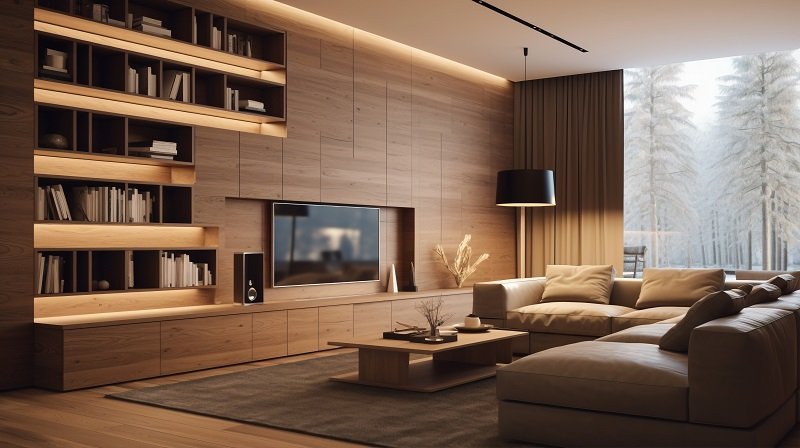Blog
Should a Sofa Be Against the Wall?

Introduction
Many people often wonder where to put their sofa set, but now you may ask if this lovely new sofa should be positioned against the wall or float elegantly in the center of the room.
This is a frequent problem for many homeowners. The placement of your sofa has a huge influence on the flow, feel, and utility of your living room. Whether you’re renovating your living room or placing furniture in a new house, the decision isn’t just about aesthetics; it’s about creating a place that suits your lifestyle and meets your needs.
Venus Home understands the value of making informed choices regarding your home’s décor. Drawing on our significant expertise in assisting people in creating their ideal rooms, we’re here to walk you through the benefits and drawbacks of sofa placement. Let’s look at whether your sofa should be attached to the wall or free-floating and what choices might improve the attractiveness and comfort of your house.

Should the Sofa Be Touching the Wall?
When it comes to positioning your sofa set, the most simple and classic choice is to have it touch the wall. This configuration offers advantages, but it may also have some disadvantages.
Pros of Having the Sofa Against the Wall
One of the primary advantages of positioning your sofa against the wall is that it maximizes available space. This arrangement opens up the center of your living room, making it appear larger and more open. This may make a significant difference in smaller rooms.
Another benefit is stability. When your sofa set is anchored to the wall, it is less likely to shift or move, which is especially beneficial in houses with pets or small children.
A sofa against the wall may provide a clean appearance. It offers a backdrop that may be enhanced with art, shelving, or a mirror to provide depth and interest to the space.
Cons of Having the Sofa Against the Wall
However, this arrangement is not without its drawbacks. One of the main disadvantages is the design constraint. Placing your sofa against the wall limits your arrangement possibilities and makes the area feel static. If you enjoy changing up your space or hosting large groups, this permanent position may not provide the freedom you want.
Another problem concerns accessibility. Sofas positioned against the wall might make it difficult to clean behind or reach power outlets.
Finally, think about the influence on traffic flow. Depending on the size and layout of your room, a wall-mounted sofa set might block natural mobility across the area.
To summarize, while positioning your sofa against a wall might save space, give stability, and create a streamlined appearance, it may limit your design options and accessibility. Analyzing the advantages and disadvantages will help you decide whether this typical layout is appropriate for your living space and lifestyle.

Alternatives to Having a Sofa Touch the Wall
If the idea of placing your sofa against the wall doesn’t quite sit well with you, don’t worry—there are plenty of other ways to position your sofa that can add flair and functionality to your living space.
-
Put Something Behind Your Sofa, Like A Console Table.
One popular idea is to place a console table behind your sofa. This not only provides an additional surface for decorative things but also serves to define the seated area without the need for a wall. This layout has the potential to create a warm, inviting ambiance as well as a focal point that quickly grabs attention.
-
Leave Room for Walkways
Another alternative is to allow space between the sofa and the wall, resulting in pathways that improve the flow of the room. This is especially handy in large rooms or open-plan designs. By doing so, you create an airy, wide environment that invites mobility and interaction.
-
Symmetry and Space Between Furniture
Creating a balanced design in your living space is as simple as paying attention to symmetry and spacing. Placing the sofa in the center and matching chairs or side tables on either side might result in a harmonious layout that feels well-planned and welcoming.
-
Create Zones
In larger rooms, dividing the area into separate zones may help it feel more organized and meaningful. Use your sofa set to create distinct sections, such as a discussion zone, a reading corner, or a television area. This strategy works brilliantly in open-plan settings when distinguishing separate tasks would normally be difficult.
-
The Gray Area
Sometimes, the best option is somewhere in the middle. Placing your sofa partially against the wall can provide an alternative, combining some of the advantages of both wall and floating setups. This may be especially useful in spaces with problematic layouts or unusual architectural features.
-
Centralized Space in the Middle
Placing your sofa set in the center of the room may be a bold and effective design option, especially in bigger rooms. This design may make your sofa the focal point while encouraging connection from all sides. It’s a fantastic method to make a comfortable meeting spot in a large living room.
-
Follow the 10ft Conversation Circle Rule
The 10ft conversation circle rule is a useful guideline for seating arrangement. Make sure that every seat is within 10 feet of one another to allow for easy communication. This guideline promotes closeness and connection, particularly in bigger settings.
-
Don’t Forget the “3 Foot” Rule
When arranging your furniture, remember the “3-foot” rule: leave at least 3 feet of walking space around your furniture. This allows for easy movement and keeps the area from feeling confined.
-
Use Sofa as A Zoning Device
Your sofa set can be a powerful zoning device, helping to define different areas within an open-plan space. By positioning the sofa strategically, you can create clear boundaries between the living, dining, and other functional areas.
-
Keep Entryways Clear
Ensuring that entryways remain unobstructed is crucial for maintaining good traffic flow and making the space welcoming. Avoid placing your sofa in a way that blocks doorways or entry paths.

These alternatives offer diverse ways to enhance the layout and functionality of your living room without necessarily placing the sofa against the wall. By considering these options, you can create a space that not only looks beautiful but also meets your practical needs and lifestyle preferences.
Conclusion
The location of your sofa set is more than just a decorative option; it’s an important part of establishing a living area that feels harmonious, useful, and reflects your style. Whether you decide to set your sofa against the wall, float it in the middle of the room, or experiment with different arrangements, the important thing is to evaluate your space, your requirements, and how you utilize your living room.
At Venus Home Furniture, we are dedicated to assisting you in finding the ideal plan that maximizes both comfort and visual appeal. With our extensive selection of couches and skilled assistance, you can convert any area into a comfortable, elegant home.
FAQs
1- Should the sofa touch the wall?
While placing a sofa against the wall is a common practice, it isn’t always necessary. Depending on your room size and layout, floating the sofa away from the wall can create a more open and inviting space.
2-What are some alternatives to having a sofa touch the wall?
Alternatives include placing a console table behind the sofa, leaving room for walkways, using the sofa as a zoning device, or centring the sofa in the room to create distinct zones.
3-Why put something behind the sofa, like a console table?
A console table behind the sofa adds extra surface space for decorative items and helps define the seating area, creating a visually appealing focal point.
4-How much space should I leave around my sofa for walkways?
It’s generally recommended to leave at least 3 feet of space around the sofa for comfortable walkways, ensuring easy movement and preventing the room from feeling cramped.
5-What is the 10ft conversation circle rule?
This rule suggests that all seating should be within 10 feet of each other to facilitate easy conversation, creating an intimate and engaging living space.
6-Can a sofa set be placed in front of a window?
Yes, placing a sofa in front of a window can be a great option. It allows you to take advantage of natural light and can create a cozy nook with a view.
7-What should I consider when placing a sofa in an open-plan space?
In open-plan spaces, use the sofa to create distinct zones. Ensure it doesn’t obstruct entryways, maintains good traffic flow, and encourages interaction by facing other seating or focal points.
8-Is it okay to place a sofa facing the mantel?
Yes, placing a sofa facing the mantel is a great way to highlight a fireplace as a focal point, creating a cozy and inviting gathering area.
9-How can rugs help with sofa placement?
Rugs can define different areas within a room, anchoring the furniture and adding warmth. Place the rug under the front legs of the sofa to tie the seating area together.
10-What are the benefits of letting furniture float?
Letting furniture float, rather than pushing it against walls, can create a more dynamic and open layout. It allows for better traffic flow and can make a room feel larger and more inviting.


